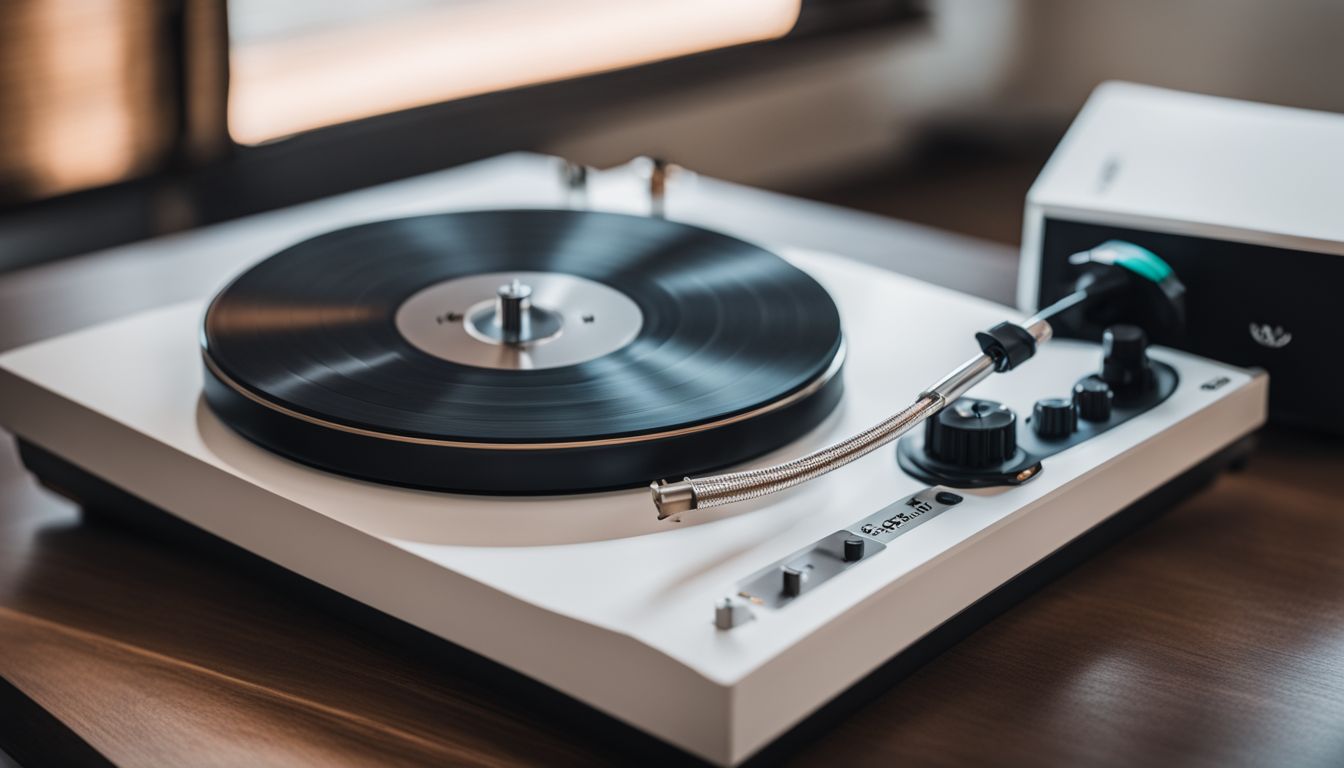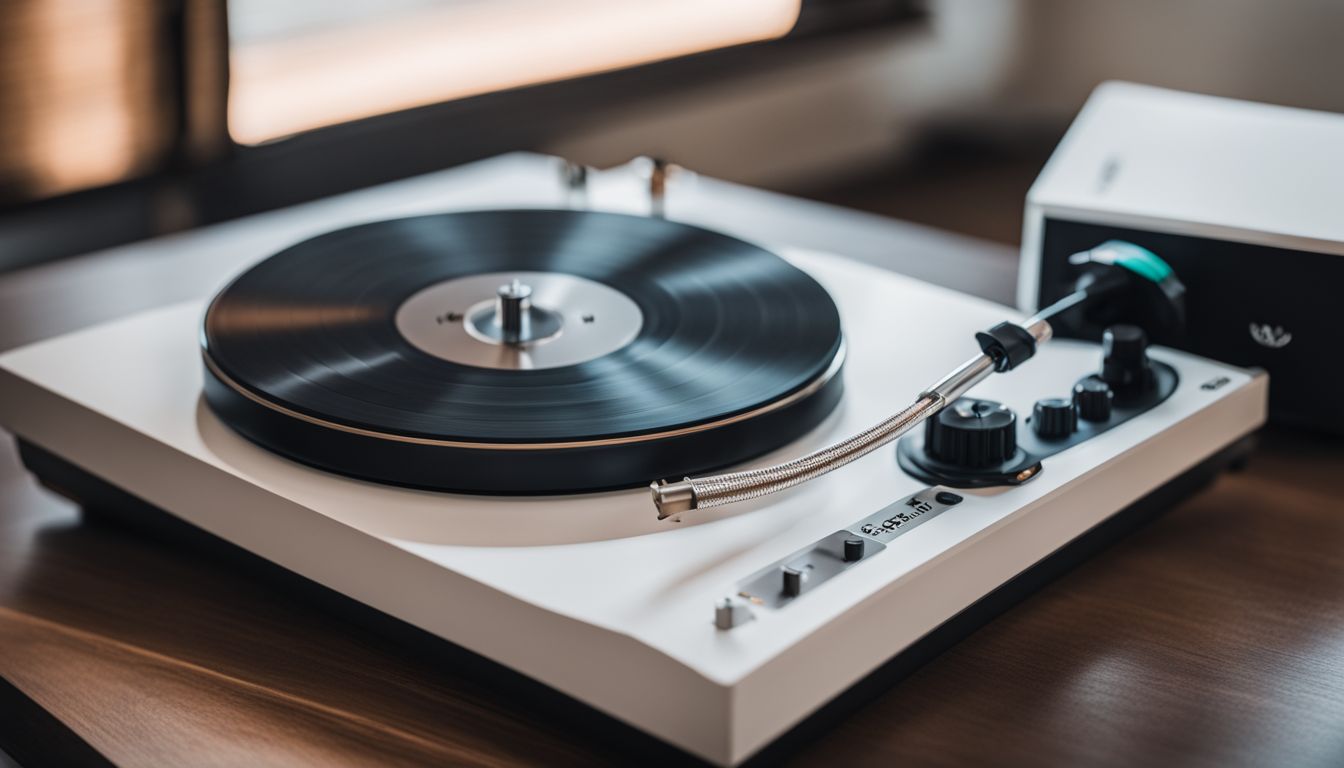If you’ve ever set up a turntable and noticed an annoying hum, you’re not alone. Grounding issues are often the culprit behind such disturbances in your sound system. This article will guide you through the essentials of a ground wire on a turntable—what it is, why it’s crucial, and how to use it effectively to enhance your listening experience.
We’ll provide easy steps to ensure your vinyl records play smoothly with pristine sound quality. Keep reading for buzz-free music sessions!
Key Takeaways
- The ground wire on a turntable protects against unwanted noise, like humming or buzzing, by providing a path for stray electrical currents to earth.
- Properly grounding your turntable improves overall sound quality, allowing for clearer and more dynamic audio playback free from interference.
- Ground loops and common mode currents can cause disturbances in your music; connecting the ground wire effectively reduces these issues, ensuring pure vinyl listening enjoyment.
- To ground a turntable record player, connect the spade connector of the ground wire to the grounding post on your amp or preamp after loosening it with a screwdriver and then retighten securely.
- If there’s no attached ground wire on your turntable or it’s double-insulated, create one using low-voltage wire connected to any metal part of the chassis and follow similar steps to establish a good connection.
Understanding the Purpose of the Ground Wire on a Turntable
The ground wire on a turntable serves as an essential defense against unwanted noise. It connects your turntable to the earth, acting as a safety route for stray electrical currents.
These extra currents can cause an annoying hum in your audio output if they are not properly diverted away from sensitive electronics within the turntable itself.
This humble copper wire often terminates in a spade or ring connector and attaches to a grounding terminal on your amp or receiver, sometimes marked with the symbol of three vertical lines decreasing in size.
When connected securely, this grounding process stops static charges from building up. That means it helps avoid that irritating buzz or hum that can ruin your vinyl listening experience.
Each connection, whether RCA jacks for audio signals, XLR inputs for professional setups, or headphone jacks for private sessions, benefits from having a well-grounded system providing clean sound free of interference.
The purpose of the ground wire is to improve electrical safety
The ground wire serves as the unsung hero in a turntable setup, acting as a critical shield against interference that could mar the pure vinyl listening experience. By securely tethering your turntable to an electrical grounding point, it plays a pivotal role in ensuring that nothing detracts from the crisp, clear sound audiophiles cherish.
Prevents humming noises
A properly connected grounding wire is essential for enjoying your turntable without the frustration of background noise. Humming noises often indicate a ground loop problem, where multiple paths to ground potential create interference.
Connecting the ground wire from your turntable to the amplifier serves as an immediate solution, creating a single path and thus minimizing electrical noise. It effectively eliminates that distracting buzz so you can experience the high-fidelity sound vinyl records are known for.
Securely attaching this wire prevents irritating sounds that can ruin your audio experience. By taking this simple step, you can prevent underlying humming from masking or interfering with the pure tones that your phono cartridge produces from traveling through speaker wires.
By using spade connectors correctly and making sure connections are secure, audiophiles can enjoy pure acoustics the way musicians and recording artists intended.
Enhances overall sound quality
Using a ground wire on your turntable does more than just silence the hum; it enhances the overall sound quality of your vinyl records. A grounded turntable interacts seamlessly with your speakers, allowing for clear and dynamic audio playback.
Without interference from electrical noise, every pluck of a guitar string and every subtlety in a singer’s voice are faithfully reproduced. This grounding process ensures that what you hear is closer to the original recording, with less distortion marring your listening experience.
Carefully connecting the turntable ground wire significantly contributes to creating an authentic auditory experience unmatched by ungrounded setups. The purity of sound achieved through proper grounding lets audiophiles and casual listeners alike enjoy recordings as they were intended—free from electronic feedback that can detract from the music’s depth and richness.
By grounding your system correctly, each note resonates clearly, making for an immersive sonic journey with every spin of the record.
Reduces ground loops and unwanted common mode currents
Ground loops create an electrical circuit that picks up interference, causing persistent hums and buzzes that spoil the turntable experience. Properly grounding your turntable breaks these loops, effectively silencing these irritating noises and enabling a clearer audio performance.
This key action stabilizes the system’s power flow and shields against disruptive common mode currents, which are often induced by other electronic devices.
Installing a solid connection between your turntable and an earthed point prevents these current disturbances from muddling your music. It’s like giving your audio signal its own exclusive lane on a busy highway—no traffic jams, just smooth sailing to high-quality sound delivery.
Ground wires act as vigilant guardians for your tunes, ensuring they travel undistorted straight to your speakers.
How to Ground a Turntable Record Player
Grounding a turntable record player is essential for reducing unwanted noise and improving your listening experience. A simple process can prevent the frustrating hum known as ground loop hum. Here’s how to properly set up the ground wire:
- Locate the ground wire on your turntable, which typically has a fork-shaped copper spade connector at its end.
- The grounding post on your amplifier or phono preamp, often labeled as “GND,” accompanies the RCA input jacks.
- Loosen the screw terminal on the grounding post slightly using your fingers or, if needed, a small screwdriver.
- Slip the copper spade connector of the ground wire onto the grounding post, ensuring a snug fit under the head of the screw.
- Tighten back down to secure the connection without over-tightening, which could damage either component.
- Obtain a length of low-voltage wire suitable for audio equipment and strip off a half-inch of insulation from both ends using wire strippers or carefully with scissors.
- Attach one end of this wire to any metal part of your turntable chassis. If there are no spark gaps available, use double-insulated tape to keep it in place.
- Connect the other end to your amplifier or phono preamp’s grounding post following the previous steps listed above.
- Plug both components into the same AC power supply outlet or power strip to minimize potential differences that can cause humming noises.
- Use multimeters to check for proper grounding by measuring resistance between two points; if done right, this can also assure safety against possible electrical receptacle issues.
Understanding RPM in Record Players (relative to the internal link provided)
Once you have your turntable properly grounded to eliminate unwanted noise, it’s crucial to understand RPM, or revolutions per minute. This term is central to the performance of record players, as it represents the speed at which the record spins on the platter.
Vinyl records are typically played at two common speeds: 33 1/3 RPM for long-playing (LP) albums and 45 RPM for singles. A correctly set RPM ensures that music plays at the intended pitch and tempo.
Direct-drive turntables allow users to adjust this setting precisely, delivering consistent speeds without much variation. Variations in RPM can cause music to sound too fast or slow, distorting the listening experience.
In order to determine whether their player is spinning records at the proper rate, maintaining fidelity, and producing high-quality audio playback, enthusiasts can use an accurate measurement tool.
Maintaining proper RPM is just as important as grounding when aiming for a system that amplifies pure, rich sounds for an optimal music experience.
Conclusion
A proper ground-wire connection ensures your turntable’s performance reaches its full potential. Eliminate that annoying hum and safeguard your listening experience by grounding your turntable without delay.
Remember, the clear, crisp sound you enjoy with each record hinges on this simple yet crucial step. Commit to a setup that honors every note and beat; make sure grounding is part of it.
Now amplify the joy of music, free from buzzes and distractions—a small change for an immense upgrade in audio quality.
To learn more about how revolutions per minute (RPM) affect your listening experience, check out our in-depth guide on what RPM means in record players.
FAQs
Why do turntables have a ground wire?
Turntables feature a ground wire to prevent unwanted noise or hum during playback. This wire helps remove interference, ensuring clearer sound when you’re amplifying your favorite tunes.
What happens if my turntable isn’t grounded properly?
Incorrectly connecting the ground wire on your turntable can cause a persistent buzz or humming sound through your speakers, disrupting the high-quality audio experience.
Is it safe to use my turntable without connecting the ground wire?
Connecting the ground wire is crucial for safety and sound quality; not using it could lead to an annoying hum in your audio and potentially pose an electrical hazard if not double-insulated.
Where does the ground wire connect to my music setup?
The ground wire should be attached from your turntable’s tonearm area to a grounding post found typically on an amplifier or receiver that connects with RCA cables for a secure link, minimizing any sound distortion.


